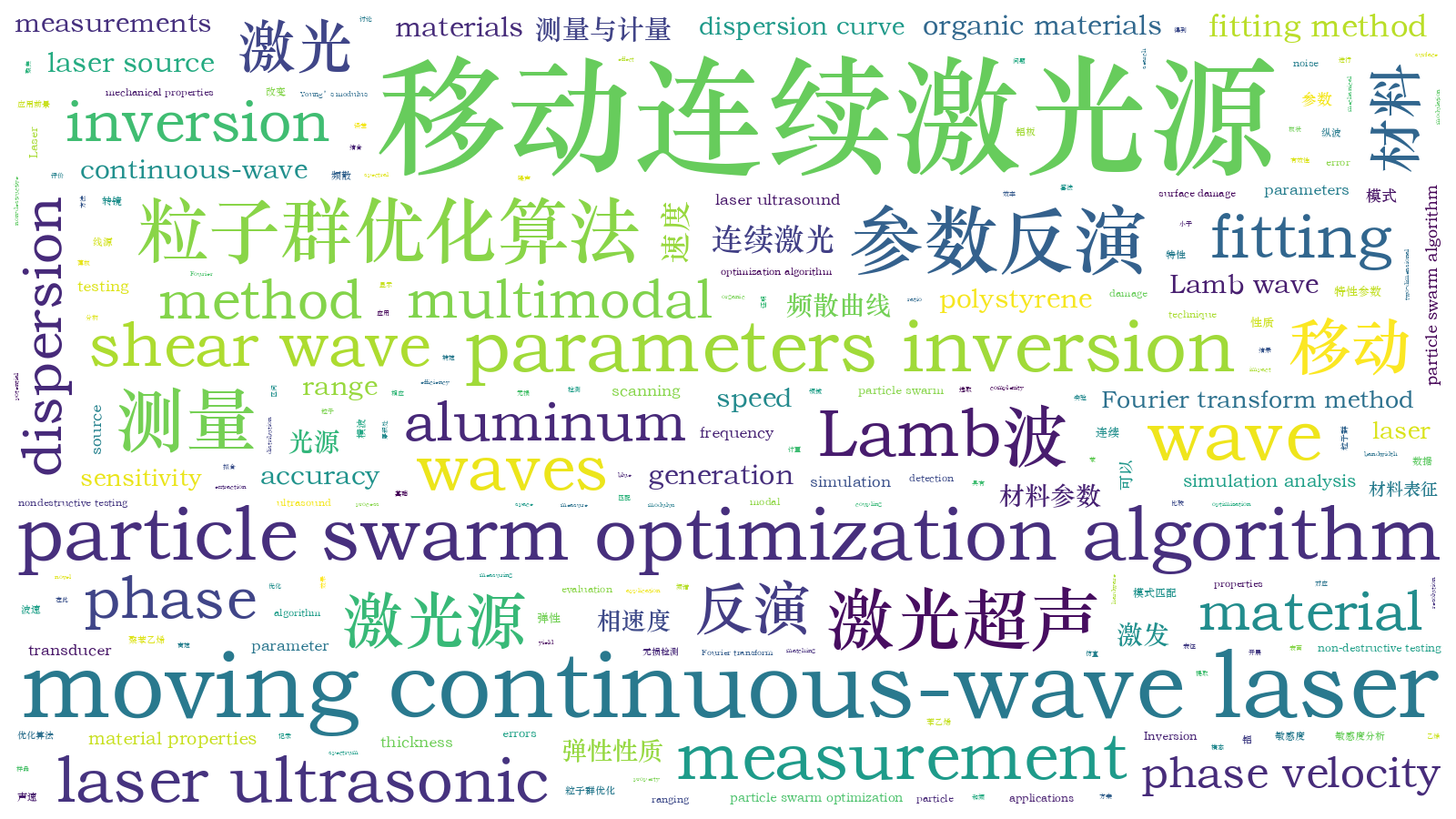移动连续激光源激发Lamb波的材料弹性性质反演
Accurate mechanical properties of materials, including Young’s modulus, Poisson’s ratio, and longitudinal and shear wave speeds, are essential for material evaluation and testing. A major challenge arises when dealing with multimodal ultrasound Lamb waves, especially those that closely approach or intersect in the spectrum or dispersion curves. This complexity is often due to hardware limitations, such as the bandwidth of generation and detection. Furthermore, accurately distinguishing these modes in dispersion curves, by identifying spectral peaks through the wavenumber resolution offered by the two-dimensional Fourier transform method, often presents difficulties. Traditionally, most studies have relied on contact wedge transducer. However, laser ultrasound introduces a nondestructive testing method that significantly simplifies spatiotemporal modulation and enables non-contact generation detection. This approach is particularly advantageous for applications that require rapid material scanning, as it overcomes the challenges associated with traditional methods, enhancing accuracy and efficiency in material property analysis.
To address challenges in material parameter inversion, a novel approach was employed, utilizing a moving continuous-wave laser source to generate multimodal Lamb waves in thin plates. This method was first validated through a material-parameter inversion study. Experimental findings, illustrated in Figs. 4 and 5, confirmed the effective generation of specific Lamb waves with distinct phase velocities. Importantly, this non-contact phase-velocity matching method overcame the limitations typically encountered with transducer use in contact scanning, enhancing the accuracy of dispersion curve measurements within the targeted range. Further investigations focused on parameter sensitivities in the fitting process, specifically for aluminum plates within a phase velocity range of 2500?4000 m/s and a frequency-thickness product range of 1?20 MHz·mm. Additionally, as shown in Figs. 2 and 3, simulations and analyses were conducted to assess multimodal fitting under various noise levels. Building on these comprehensive insights, material parameters for aluminum and polystyrene plates of varying thicknesses were successfully obtained through the application of the particle swarm optimization algorithm, coupled with inertial descent.
Single-modal data (specifically, the s1 modal, represented by the blue data points in Fig.5(d)) are utilized for fitting when inverting the material properties of the polystyrene plate. When comparing the final fitting results with parameters found in the literature, the error for the longitudinal wave speed is only 0.26%, while that for the shear wave speed is 3.83%. A sensitivity analysis of this study reveals that the sensitivity of the longitudinal wave in the phase velocity range of 2500?4000 m/s for the aluminum plates is relatively low. Errors in the measurement of the dispersion curve can lead to significant deviations in the inversion results of the longitudinal wave speed. However, employing multimodal fitting can reduce the inversion errors originating from these low sensitivities, as illustrated in the results presented in Table 1. In this study, multimodal-based fitting inversion results yield a longitudinal and shear wave speed errors of 1.51% and 1.28%, respectively, compared to the existing literature. These results underscore the relative accuracy of the dispersion curves generated by Lamb waves and extracted using measurement techniques.
In this study, a method involving the generation of Lamb waves using a moving laser source is employed to measure the Lamb waves with phase velocities ranging from 1000 to 4000 m/s and frequencies ranging from 1 to 20 MHz. This technique is applied to both aluminum plates (thickness: 0.5?1.6 mm) and polystyrene plates (thickness: 2.3 mm). This method effectively circumvents the limitations associated with transducer coupling during contact scanning, by utilizing non-contact generation. This approach significantly enhances the accuracy of measuring the dispersion curves within a specified range, enabling precise extraction of the phase velocity and frequency. The simulation analysis in this study investigates the impact of sensitivity and fitting modes on the inversion results. The sensitivity of the longitudinal and shear wave speeds in aluminum within phase velocity and frequency ranges of 2500?4000 m/s and 1?20 MHz, respectively, are discussed. Notably, this region exhibits higher and lower sensitivities to shear and longitudinal wave speeds, respectively. The simulation analysis reveals that noise has a more pronounced effect on longitudinal wave speed, resulting in larger deviations. In this study, a multimodal fitting method is utilized to enhance the accuracy of the final inversion results. This approach effectively addresses the challenge of multipeak distribution in the search space, which is commonly encountered in unimodal fitting methods. By leveraging accurate dispersion data obtained through simulation analysis, the particle swarm algorithm with inertial descent is applied to invert the longitudinal and shear wave speeds in aluminum and polystyrene plates. The maximum error between the final inversion results and that in the existing literatures for the aluminum plates does not exceed 1.51%. Furthermore, our experiments with polystyrene plates demonstrate that a moving laser source can successfully generate Lamb wave signals with low phase velocities, particularly in organic materials with limited surface damage thresholds. This promising technique holds significant potential for future applications in non-destructive testing and evaluation of various non-metallic materials, particularly those prone to damage, such as composites.
李秋雨, 李政, 陆健, 阚威威, 沈中华. 移动连续激光源激发Lamb波的材料弹性性质反演[J]. 中国激光, 2024, 51(8): 0804006. Qiuyu Li, Zheng Li, Jian Lu, Weiwei Kan, Zhonghua Shen. Elastic Property Inversion of Materials via Lamb Waves Generated by a Moving Continuous‑Wave Laser[J]. Chinese Journal of Lasers, 2024, 51(8): 0804006.







